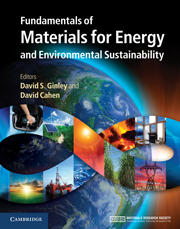Book contents
- Frontmatter
- Contents
- Contributors
- Preface
- Acknowledgments
- Part 1 Energy and the environment: the global landscape
- 1 A primer on climate change
- 2 The global energy landscape and energy security
- 3 Sustainability and energy conversions
- 4 Energy cost of materials: materials for thin-film photovoltaics as an example
- 5 Economics of materials
- 6 Global energy flows
- 7 Global materials flows
- 8 Carbon dioxide capture and sequestration
- Part 2 Nonrenewable energy sources
- Part 3 Renewable energy sources
- Part 4 Transportation
- Part 5 Energy efficiency
- Part 6 Energy storage, high-penetration renewables, and grid stabilization
- Summary
- Appendix A Thermodynamics
- Appendix B Electrochemistry
- Appendix C Units
- Index
- References
6 - Global energy flows
from Part 1 - Energy and the environment: the global landscape
Published online by Cambridge University Press: 05 June 2012
- Frontmatter
- Contents
- Contributors
- Preface
- Acknowledgments
- Part 1 Energy and the environment: the global landscape
- 1 A primer on climate change
- 2 The global energy landscape and energy security
- 3 Sustainability and energy conversions
- 4 Energy cost of materials: materials for thin-film photovoltaics as an example
- 5 Economics of materials
- 6 Global energy flows
- 7 Global materials flows
- 8 Carbon dioxide capture and sequestration
- Part 2 Nonrenewable energy sources
- Part 3 Renewable energy sources
- Part 4 Transportation
- Part 5 Energy efficiency
- Part 6 Energy storage, high-penetration renewables, and grid stabilization
- Summary
- Appendix A Thermodynamics
- Appendix B Electrochemistry
- Appendix C Units
- Index
- References
Summary
Focus
As we search for solutions to providing energy in a sustainable manner to a growing world population that demands a higher quality of life, it is instructive to understand the distribution of energy available on our planet and how it is used. This chapter provides a description of the energy resources on Earth and the transformations that they undergo in both natural and human-driven processes.
Synopsis
Earth is continuously exposed to large quantities of energy, primarily in the form of solar radiation, a small fraction of which is stored through a series of biochemical and chemical transformations, whereas most of it is dissipated through natural processes. Additionally, huge reservoirs of energy exist on the planet from the time of its creation several billion years ago, mainly as radionuclides and thermal energy embedded in the Earth's crust and interior.
- Type
- Chapter
- Information
- Publisher: Cambridge University PressPrint publication year: 2011

